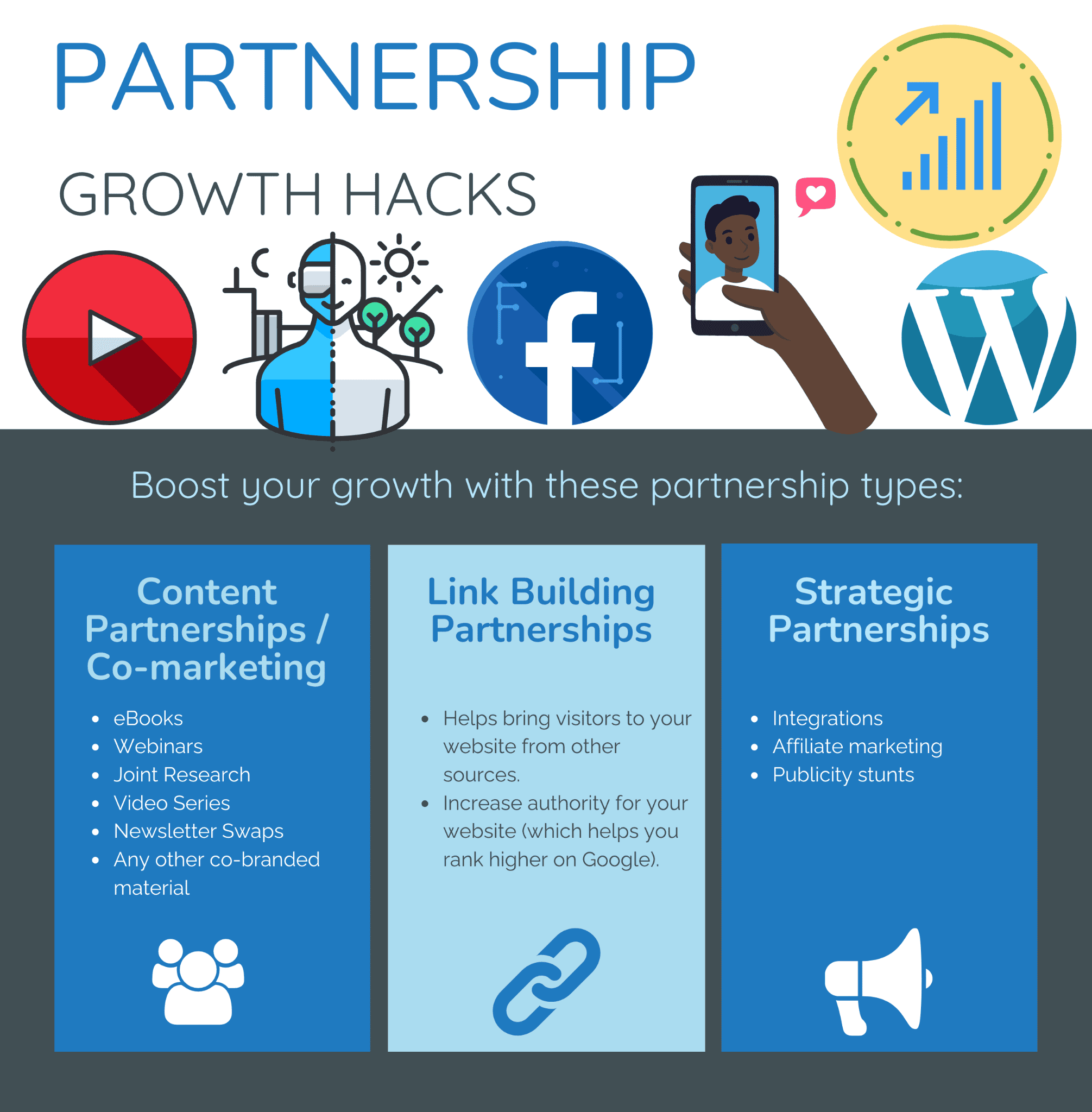Everyone is on the lookout for a fast fix or a hack that will solve all of their business’s growth issues – basically the ultimate growth hack.
The reality is that it takes more than just vibrant buttons that change color or exit pop-ups that disappear to boost your development effectively. Though, of course, optimization can’t be disregarded; it just takes more than that to actually “grow.”
[playht_player width=”100%” height=”175″ voice=”Mark”]
Real progress cannot be achieved with quick fixes! There are no shortcuts to success, and it’s the result of a thousand small victories, not of a single “get-rich-quick” scheme.
So if you’re looking for a “one-size-fits-all” solution, this definitely isn’t the right place for you to read this. If, on the other hand, your marketing plan goal is to learn how to create long-term, sustainable development, you’ve come to the correct spot!
While many people have misunderstood what growth hacking is, the aim is still the same: to find new, creative, and cost-effective ways to build your business at all stages.
Here, we’ll explain why partnerships are the finest hack you can utilize and how to put them to work for your company’s benefit.
What is growth?
Users, leads, upgrades, income, and profits are all examples of growth. It’s essential to the survival of any company.
Marketers and the marketing team do not “own” this term. It’s everyone’s responsibility, from the engineers to the product team to the customer service staff.
All of your actions are guided by hypothesis-driven experimentation in order to discover what works and what doesn’t.
But what is growth hacking?
In light of the frequent misunderstandings around the phrases “growth hacking” and “growth hacker,” it’s worth revisiting the term’s original meaning.
In his words, this is someone whose true north is to achieve development for a brand. Ellis explains that everything they do is examined for its possible influence on scalable growth.
As a result, growth is the star around which a this hacker orbits. A company’s every move aims to grow traffic or boost revenue.
New strategies for increasing conversions, registrations, and/or upgrades have begun to gain traction, ranging from viral loops to basic onboarding and email marketing hacks. As a result of overuse, the effectiveness of these strategies gradually dwindled.
Even said, the ultimate aim of this strategy is still the same: to uncover low-cost ways to develop your business.
So, what makes partnerships the ultimate growth hack?
Admittedly, some of us may have been swayed by the promise of “growth hacking” as well. At some point, we may have tried attempting to find the one solution that would address all of our growing issues.
If not hundreds, there are numerous slew “growth hacks” that you may have even tried, including SEO tricks, G2Crowd and Capterra reviews, exit pop-up hacks, gamification, and more.
Some of these strategies might work for a short time, but we must admit that they were either not scalable and durable or just ineffective.
If you’re anything like us at the beginning of your business journey, with no clients, income, brand, or even a network to operate with, then forming partnerships may have been the only viable path you could have pursued.
From our experience, they not only helped us acquire the exposure and leads we needed right away, but they also had a significant impact on our long-term growth, such as:
- Helped establish our social proof in the eyes of others;
- Set us up as “thinking leaders” in our field because of it;
- Expanded our reach to a larger demographic group (and a new audience);
- Increased brand retention, which attracted stronger business partners.
In achieving all this, we have realized that the compounding nature of partnerships is the key to success.
Knowing the “Partnership Compounding Cycle”
In the financial sense, compounding is the capacity of an asset to create earnings, which may then be reinvested in order to generate more profits. The more time you put into your investments, the more money you’ll make each year.
Likewise, in the marketing field, partnerships also have a “compound interest” aspect, which is exactly what makes it the best growth hack we’ve ever come across.
Let me illustrate to you how partnerships mirror the compounding cycle:
- You collaborate with Company X.
- This collaboration provides you with access to Company X’s audience.
- These leads are nurtured and converted into customers.
- The exposure and relationship with Company X contribute to the credibility of your brand.
- Your trustworthiness helps you acquire better partners.
- Repeat.
To put it another way, the more partnerships you have, the more exposure you’ll get, which in turn increases your number of users and social proof, allowing you to work with even more high-quality companies, and the cycle continues.
Picking the right partners

For partnerships, there is no “one-size-fits-all” guidebook that can be followed. But you may ask yourself a few questions to find the ideal partners for you:
- Do they have a customer base that is similar to my company’s?
- Is there a potential for a conflict of interest? How similar are our products and services, and how similar are our keyword strategies?
- By partnering with you, how many more prospects will I receive? Do I think it’s big enough to justify my time?
- How well-known is this brand?
- Are the individuals you’re working with pleasant to be around?
Use these questions to determine if you should work with a particular brand or company. It’s always better to surround yourself with credible business partners within your circle.
Meanwhile, these are the signs that they’ll make a fantastic partner:
- They are a well-known brand in their field.
- They have a comparable target market.
- They are not a rival.
- They have a sizable audience (email list, social following, etc.).
- They are easy-going and adaptable to work with.
For startups in the early stages, this means you’ll have to make do with lesser partners. However, if you keep this cycle continuing, your partners will swiftly grow into the greatest names in the business before you realize it!
Types of partnerships you can use to accelerate your growth

If you and your partner have a similar product and audience, you’ll be able to determine the sort of collaboration you should pursue.
These are three types of collaborations that best works with an array of business models:
Content Partnerships / Co-marketing
Partnerships between two or more firms are known as co-marketing, and they generally involve a co-branded piece of content that promotes a joint offer.
Co-marketing ventures can take many forms, but the following are the most notable:
- eBooks
- Webinars
- Joint research
- Video series
- Newsletter swaps
- Any other co-branded material
Projects like these aim to create mutually beneficial collaborations that generate leads and bring value to all parties involved.
A piece of content that connects with both your audience and theirs would be the result of bringing together your resources and experience.
Our experience has been that these collaborations often begin a long-term engagement with the company in question.
In this case, picking the correct partner and providing as much value to that partner as possible is critical.
It is more probable that the partner will expand the cooperation in the future if you demonstrate the value of the alliance and your ability to deliver on a promise.
Link Building Partnerships
Link building is the practice of obtaining other websites to link back to your website. There are two key advantages of gaining backlinks to your pages:
- It helps bring visitors to your website from other sources.
- An increase in authority for your website (which helps you rank higher on Google).
Additionally, search engines still use this method to decide which pages are displayed at the top of their results for specific keywords. You’ll see a rise in your Google ranks due to backlinks from high-quality websites.
We’ll look at the three major methods we established links to all of our blog articles and “boring pages” (homepage and other landing pages) in this article.
Link Exchanges
Companies and blogs utilize this approach to gain backlinks the most frequently. Basically, you link to your partner’s page in an existing blog post, and they’ll link to one of your pages on their website in exchange for the easy partnership.
Even though this strategy appears to be effective, Google may punish you if you do it too frequently. Hence, this isn’t a recommended strategy, and companies are advised to proceed with caution when using this tactic.
Guest Posting
To be honest, this one doesn’t need much of an explanation. The first step is to get in touch with an authority blog in your field and offer to write a guest post on their site. Building your personal and brand authority through guest blogging is an excellent way to expand your audience.
Adding a link to your site in your author bio is typically acceptable by the blogs you collaborate with. It’s also a good idea to incorporate some backlinks inside the content itself, as well.
However, keep in mind to only link back to your blog posts when they are directly related to the guest post you’re writing on your own website or blog. Moreover, don’t forget to heed the advice of Google on guest posting.
Guestographic Method
This is a novel approach to link building that makes use of infographics. An infographic may be easily created on your site, then shared with other bloggers who are writing about the same subject matter to see if they are interested in using it.
The infographic can also be used in a short blog post. You are more likely to succeed with this strategy since you are providing value to your partners rather than merely asking them for a connection.
With this method, you can also offer to condense extensive blog articles on external websites with an infographic in exchange for a link to one of your partner’s blogs.
Afterward, you can ask them for an outline and swiftly produce an infographic with all their material.
Co-marketing efforts are slower but more successful than link-building collaborations.
As with any other collaboration, you can treat this one the same way you would any other: an opportunity to cultivate a long-term connection with these companies and broaden your network of relationships.
Strategic Partnerships
This takes us to the final type of partnership that might help you hack your growth. There are several ways in which you might collaborate with other businesses in your sector to benefit both parties.
Below are some of the tested and proven strategic partnerships to boost your growth:
Integrations
This style of business promotion involves standardizing all parts of marketing communication, including advertising, public relations, social media, and the company’s website.
To ensure the smooth growth of the firm and the regular flow of new and returning consumers, the plan is to build a mix of promotional activities that will be conducted on many platforms.
By using marketing integration, you may create all your advertising channels in an integrated way that is meaningful and consistent. Integrations allow businesses to increase their product offerings while improving the consumer experience considerably.
Affiliates
Affiliate marketing is an excellent approach to connecting with clients who are most enthusiastic about your business or product. You enable consumers to become ambassadors for your product by paying them for their referrals.
The same may be said about working with influential people in your industry, such as bloggers and companies, and paying them for their endorsements.
Marketing and Publicity Stunts
It’s certainly the most difficult type of partnership to pull off, but it can be a game-changer when done well.
Often neglected by most marketers, collaborating with other businesses to go viral or execute a marketing stunt reduces your potential cost by half and doubles your chances of successfully executing your campaign.
Leveraging the Ultimate Growth Hack for Partnerships
A growth mindset is a gradual process that takes place over time, and it takes hundreds of little trials, tweaks, and hacks to achieve something sustainable and scalable.
However, you may speed up your progress by using the tremendous compounding nature of partnerships. As your business grows, the more successful each collaboration will be for your growth.
If you want to expand your customer base, improve the recognition of your brand, or simply boost your bottom line, forming partnerships is a certain method to do all three.


